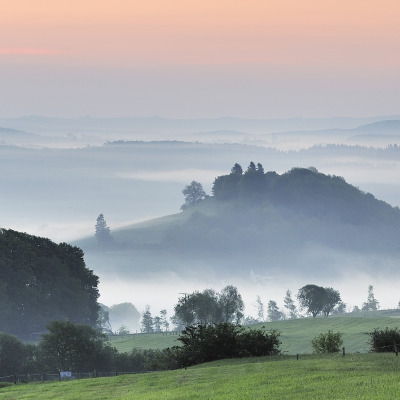#volcanic eifel
Text



V for Volcano
7K notes
·
View notes
Text
fascinating to read about volcanic activity in europe. did u guys know the carpathians may still be undergoing subduction and that there’s evidence to suggest there’s a growing magma chamber under the eifel
#imagine if a volcano erupts in Germany….#(LIKELY NOT IMMINENT but there’s seismic activity in addition to the escaping gases!!(
19 notes
·
View notes
Text
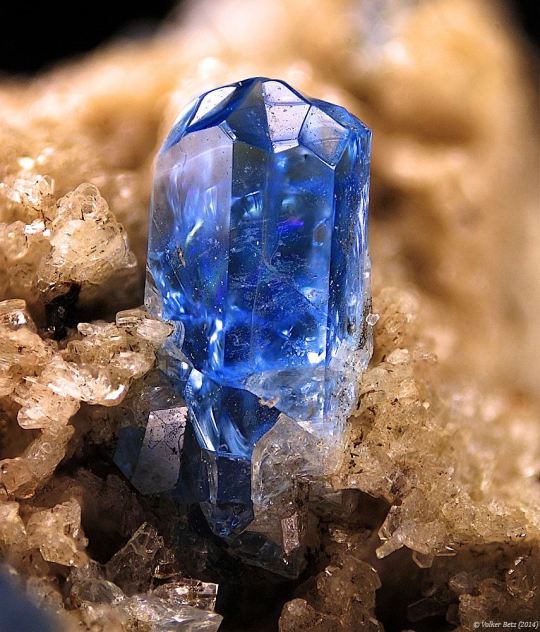
In den Dellen quarries, Niedermendig, Mendig, Laach lake volcanic complex, Eifel, Rhineland-Palatinate, Germany
5 notes
·
View notes
Text
I thought I'd demonstrate what my Wikipedia rabbit holes tend to look like, using my currently open tabs.
First thing first: In January, I realised I didn't have any firm, or even shaky, knowledge of Russian history, talking middle ages up to, say, Peter the Great (my knowledge does not improve after Peter the Great, but I am currently disinterested in anything post-1700). So, I decided to fix this.
When I want to learn the fundamentals of a topic, I always go with Wikipedia instead of books. Why? Books are a larger investment. What if I don't find the topic interesting in the long run? Wikipedia articles are me dipping my toe in the water, improving my allmänbildning without having to complicate things with in depth knowledge. I feel like this is completely normal.
Okay!
So, um. I never go to the obvious Wikipedia article right from the start when I'm about to head down a rabbit hole. I have to get to the topic I'm after via link hopping from the Wikipedia article I already have open (and I usually have one open, because I like learning and I'm always looking stuff up). I don't need to end on the specific "History of Russia" article, or whatever. I count it as a win when I reach a page that's related to the actual topic. Iirc, in my Russian history rabbit hole, I'm pretty sure it was the article on the Volga.
Success! I start reading and following links. Then I start opening new tabs to a group when I begin hitting divergence points. That's when I start finding multiple links on a new page that interests me, and it's going to get too complicated for me to mentally keep track of where I was, what I wanted to read, where I started. That's normal.
At no specific point, I go "whoops, that's too many tabs, I better start chewing through them" and hopefully not open new new tabs from the new tabs. And I start reading articles from least to most relevant on the principle that this is least likely to cause more tabs to my Goal Topic so I can close tabs.
So! This is what my Russian history tab group currently looks like.
Saqilaba
Volga trade route
Jüz
Jarlig
Ivan the Terrible
Alexander Nevsky
Collector of Russian lands
Rus' people
That's a decent collection of links!
But okay, sometimes I misclick and open a link as a new tab outside the group. Annoying. I try to read rid of these pages first. Except...
Sometimes the topic of that article ends up being really interesting. And then I accidentally start a new rabbit hole.
At some point in the Russian history rabbit hole, I opened an article related to the Middle East. Can't remember what the original one was, but one way or another I ended up reading about the Phoenicians. Whoops. That's a new rabbit hole.
Currently, it's more of a Carthaginian tab group. It looks like this:
Tartessos (via Cadiz, via Carthage, which is the ~actual~ tab. I'm just accidentally on a brief several week break from Carthage)
William Martin (Royal Marines officer) - This is a fake persona created for a dead body for the Allied Operation Mincemeat during WWII. It's linked from the article on Huelva, which I've already read and closed.
Medellín, Spain
Girsu - This is an ancient Sumerian city, still hanging around from when this group was about Phoenicians.
Abydos, Egypt - Similarly as Girsu. This is still hanging around because the article looks really interesting, and I want to savour it.
Short and sweet! Except...
I accidentally opened a tab about Mount Cameroon (which is because of Carthage, I swear). Well, no problem. Just read and close it quickly. It's a depressingly short article.
There's just one thing. I am fascinated by volcanoes. Oh no. Some link hopping later, I have another tag group. It's the one I'm currently trying to read away. It looks like this:
2021 European floods - via Eifel, a mountain range in Germany, which is volcanically active (yes, really! I'm fascinated/horrified).
Khyber Pass
Matronae Aufaniae
Ahr Valley
At least this is definitely not long and I'm definitely not going to be allowed to open tabs, this is not relevant to any rabbit hole I'm currently in, it's just my vulcanophobia and river obsession misbehaving.
And that's it. I have to finish reading these articles (but not necessarily closely) because I'm trying to stay accountable to myself and actually complete things.
This is a cry for help.
1 note
·
View note
Text
A Brief Introduction of Sodalite
The main identification features of sodalite: dark blue, polycrystalline structure, low RI1.48, low SG2.28 floating in a heavy liquid of 2.65, turning red under the Charles color filter, magnifying and observing the distribution of visible white matter in it. The color is closer to that of lapis lazuli. The main distinguishing point is that lapis lazuli is a variety of mineral combinations, with pyrite particles and calcite distributed in star dots or lumps. Sodalite is a kind of feldspar minerals. It is a chloride-containing sodium aluminosilicate. Sodalite is similar in color to lapis lazuli, and it is also called “Canadian lapis lazuli”or “bluestone”commercially.
Introduction of sodalite
Sodalite is a kind of feldspar minerals. It is a chloride-containing sodium aluminosilicate. Sodalite includes hydroxyl sodalite, tetrazite, bluesite, etc. Different types of sodalite have different colors. The shadow of tetrazite is often seen in volcanic eruptions. Its colors are gray, brown, and blue. In addition to blue, blue ashlar also has white, gray, green, etc. It is a common gem and is produced in France, Brazil, Greenland, Russia, Myanmar, Romania and North America.
Appearance characteristics of sodalite
Sodalite is usually blue, a few are white, green, red, purple or gray. Crystals are quite rare, and are mostly produced in the form of lumps, grains or nodules in nature. Generally glassy luster, on the cleavage surface, it is greasy luster. Sodalite is a silicate mineral containing sodium, aluminum and chlorine. When nitric acid is added and silver nitrate is added, white silver chloride will be precipitated. If chlorine in the composition is replaced by sulfur, sodalite (Hackmanite) is formed. Sodalite is rare in nature, and its appearance is quite similar to that of lapis lazuli (Lazurite). Therefore, it is often used as a substitute for lapis lazuli in the gem market, but sodalite rarely contains the characteristic pyrite inclusions of lapis lazuli.
Physical Properties of Sodalite
Crystal system: equiaxed crystal system
Crystals: rhombic dodecahedron, cubic dodecahedron, octahedron
Aggregates: granular, massive, nodule
Hardness: 5.5~6
Decomposition/Fracture:{110} Decomposition: Poor to Clear; Jagged to Shell Fracture
Gloss: Glass Gloss
Color: blue, gray, white, green or red
Streaks: white or very light blue
Specific gravity: 2.14~2.30g/cm3
Others:(1) Under ultraviolet radiation, orange or orange-red fluorescence is often produced
(2) with brittleness
(3) Translucent to opaque
(4) When heated and melted, it will foam and become colorless glass
Field production of sodalite
Sodalite is relatively rare in nature. It is mainly produced in alkaline rocks rich in sodium and poor in silicon, such as nepheline syenite, trachyte and xanyan and other igneous rocks or contact metamorphic silicite, often with nepheline, leucite, feldspar, zircon and other minerals symbiosis.
Maine in the United States and Ontario in Canada produce high-quality blue sodalite. In addition, the Ural Mountains in Russia, the Vesuvius Mountains in Italy, Norway, Germany and Bolivia all produce sodalite. A bright blue almost transparent sodalite was found in Southwest Africa.
Important Origin of Sodalite
(1) Litchfield and West Gardiner in Maine in the United States, Red Hill in New Hampshire, Salem in Massachusetts, Magnet Cove in Arkansas, Cripple Creek in Colorado and other places
(2) Mt. St.-Hilaire in Quebec in Canada, Davis quarry in Ontario and quarry in eastern and Princess Bancroft, and Ice River complex in Columbia in British
(3) Greenland Kangerdluarssuk, Tunugdliarfik fjords
(4) Norway’s Langesundfjord area
(5) Scarrupata and Mte. Somma in Campania, Italy, Val di Noto in Sicily
(6) Laacher See area of Eifel, Germany
(7) Miask, Kola Penin of Ilmen Mts, Russia.
(8) Kishengar of Indian Rajputana
(9) North Korea Ham Gyong North Prov. Gil Ju Co.
(10) Tiahuanaco in Bolivia

0 notes
Photo

Buchite on Scoria matrix
Locality: Emmelberg, Üdersdorf, Daun, Eifel, Rhineland-Palatinate, Germany
~~~~~~~~~~~~~~~~~~~~~~~~~~~~~~~~~~~~~~~~~~
“A compact, vesicular or slaggy metamorphic rock of any composition containing more than 20% vol. of glass, either produced by contact metamorphism in volcanic to subvolcanic settings or generated by combustion metamorphism.
An uncommon metamorphic rock type composed mostly of glass, formed by the melting of a sedimentary rock or soil by extreme heat from an adjacent lava flow or scoria eruption, or the burning of an underground coal bed. Buchite is a product of a special type of metamorphism, called pyrometamorphism (contact type, high to very high temperature, low pressure, often connected with coal fires). Buchites are often confused with obsidian, which is a volcanic glass rather than metamorphic glass. The so-called para-obsidian is a buchite with small amounts of mullite and tridymite forming microlites. Rarely, buchites can be colorful and transparent, and faceted as gemstones, as for example a few blue-green gems from the Eifel hills in Germany.
The original description of buchite was for partly fused, glassy sandstones associated with basalts (in Germany). Now the term also covers more pelitic rocks. The first described buchite contained relic, cracked quartz with tridymite overgrowths and inclusions, feathery or needle-like clinopyroxene, magnetite, cordierite crystals, tiny crystals of a spinel, small voids, pores interfilled with goethite and brown glass.
According to Grapes (2006), buchite also occurs as xenoliths and within contact aureoles.” - https://www.mindat.org/min-50131.html
Basically what this means for this rock, is that there was a scoria eruption (a volcanic eruption with lots of air bubbles in the magma) that came into contact with some sandstone. The intense heat of the magma was able to melt some of the sand, which then rapidly cooled and became glass. You can even still see the darker bands beneath the glassy layer, displaying this xenolith’s sedimentary origins!
This is my first time playing with the “Read More” function in order to provide some more information or an explanation, so please let me know if you read it and/or it is something you’d like to see more of in the future!
#buchite#scoria#buchite on scoria#germany#rock#glass#metamorphic#partial melting#metamorphic glass#description#explanation#read more#rocks#minerals#fossils#geology#mineralogy#earth#nature#science#first time experimenting with a read more#but this is a neat thing that needs explaining
871 notes
·
View notes
Text
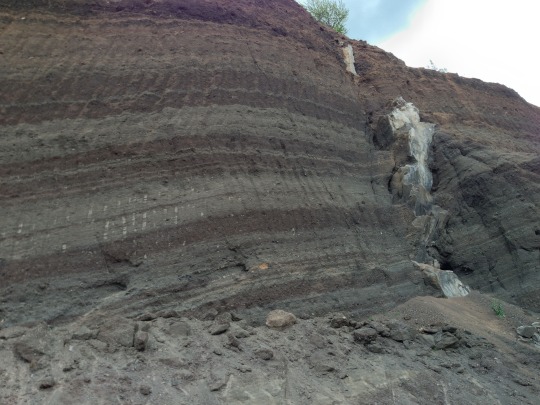
Quarternary melilith nephelinit scoria cone Herchenberg volcano with main feeder dyke, quaternary volcanic field east Eifel, located near Brohl Germany. The beautiful colorful bedding are minor cyclic changing types of eruption mechanism between major strombolian and minor phreatomagmatic eruptions. The water magma interactions where near the surface in tertiary clay layers and quarternary sand and gravel of rhine terraces. You can see fragments of brown and red cluster of headed clay and white pebbles in the ash layers. The first eruptions have massiv contact with the groundwater and are phreatic. Then the intensity of eruptions change to the strombolian type without water contact or interactions. The flow was brocken or close. Most of the other basanite tephrite scoria cone volcanos in the quarternary Neuwied basin have in the prea beginning phreatomagmatic tuff cones.
#volcanic#original tumblr photo#original photographer#scoria cone#dyke#Herchenberg#Brohl#geology#quarternary
1 note
·
View note
Text
From Collector to Director
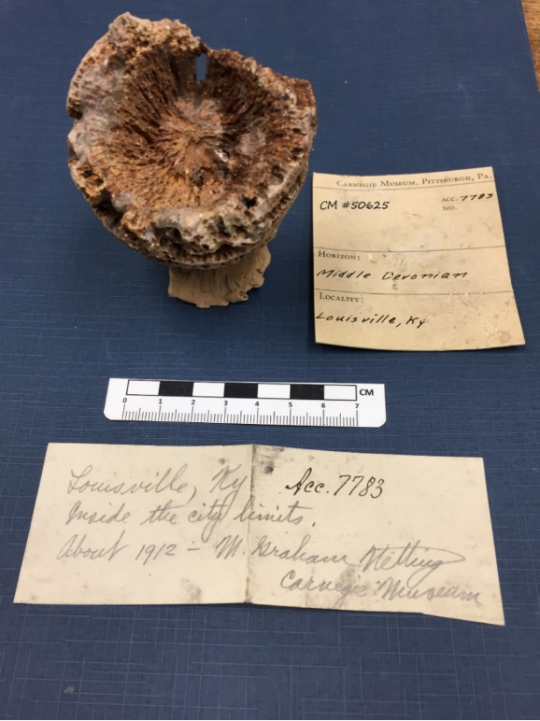
Figure 1: CM 50625 – Rugosa Coral. Collected by M. Graham Netting in 1912. Coral body shape has a radial symmetry.
In 1912, eight-year-old M. Graham Netting unearthed 13 coral fossils within the city limits of Louisville, Kentucky. Later, as a 22-year-old Pitt student, he donated them to the Carnegie Museum of Natural History (Figure 1). When the Great Depression cut short his graduate studies at the University of Michigan in 1929, he returned to the museum as Assistant Curator of Herpetology, and worked his way up to Curator in 1932. In 1954, six months before turning 50, he was appointed Director of the Carnegie Museum of Natural History. Along the way, the Wilkinsburg native left an astonishing legacy that includes a steady growth in scientific collections, numerous wildlife dioramas in the Halls of Wildlife, and a mid-Appalachian field research station, Powdermill Nature Reserve. Upon his retirement in 1975, the Post-Gazette noted, “Long before it was “in,” Netting saw pollution of the air and water ravaging the land.”
Albert Kollar, Collection Manager of the of Section of Invertebrate Paleontology, re-discovered young Graham Netting’s horn corals while working on a multiyear review of the Bayet Collection. Netting’s label note did not provide any evidence for the stratigraphic unit that he collected from, but more on that later.

Figure 2: Carnegie Museum of Natural History exhibit reconstruction of an Early to Middle Devonian reef, 375 - 390 MYA. The reef shows Rugosa and Tabulate corals, a spiny trilobite about 18 inches in length and several straight cephalopods. Coral tentacles (shown in white) are illustrated in feeding mode. Both Rugosa and Tabulate corals went extinct at the end of the Permian Period.
Rugose corals are often called horn corals because many species have a horn shape. Horn corals attach to the sea floor by way of a sticky tentacle that protrudes from the base or curved end of the animal. Other invertebrate animals, such as brachiopods, attached in this position are described as sessile. The coral animal or “polyp” built its skeleton from calcium carbonate, a mineral formed from Bicarbonate and Calcium ions in seawater. The polyp tentacles or feeding polyp extend out from the top of the basic body for feeding (Figure 2). When the animal died, its soft tissues would have decayed and left behind the external hard mineral skeleton that fossilized.
Netting’s Louisville coral specimens are fossilized in a different way than similar corals from the nearby Falls of the Ohio middle Devonian fossil beds. His corals are lighter and fragile to the touch, conditions which gave Albert reason to compare Netting’s fossils to similar invertebrate paleontology corals from strata within the Louisville area. Sometime during or after burial, these horn coral skeletons were replaced by silica or quartz, a process known as silicification. The mineral silica can saturate a column of seawater when the seabed is overwhelmed with a large population of sponges. Sponge skeletons are composed of silica and when they die silica is added to a column or more of seawater. Volcanic eruptions eject silica into the atmosphere that eventually settles into the sea. Again potentially adding higher amounts of silica. Whatever the cause, Albert believes Netting’s corals were collected from the fossiliferous Middle Devonian age Jeffersonville Limestone, where the “lower foot of a “conglomerate” of reworked silicified Louisville Limestone” of Upper Silurian age is known to occur with silicified coral fossils (Conkin and Conkin, 1972).
Horn and Tabulate corals thrived in shallow seas forming diversified ecological reefs from about the late Silurian Period to the beginning of the Late Devonian epoch. During the Middle Devonian epoch roughly 400 Ma to 390 Ma years ago, reefs formed in central New York, southern Ontario, central Ohio, central Iowa, western Alberta, Canada, western Australia, and in Eifel, Germany.

Figure 3: Paleogeographic Map of the Middle Devonian Period – Kentucky is well south of the equator.
Louisville, during the Devonian Period, was centered in the southern hemisphere about 40 degrees south of the equator. Because of plate tectonics, the coral beds of Louisville would travel 5,500 miles over the next 390 million years to their present-day location of 38 degrees north (Figure 3). Today, fossil outcrops in the city limits of Louisville are difficult to find.
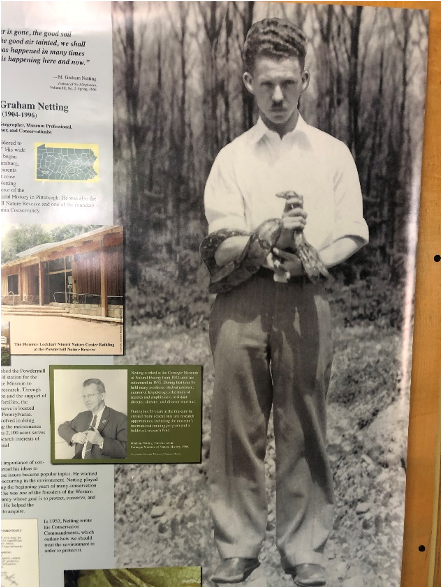
Figure 4: Graham Netting in his twenties.
When Netting retired as Director of Carnegie Museum of Natural History, he moved to a modest house next to Powdermill Nature Reserve. A seat was saved for him each Sunday at the reserve’s weekly nature talk. In 1996, he passed away. Steve Rogers, Collections Manager for the Section of Birds, recalls sipping fresh lemonade on Netting’s back porch in 1981. According to Rogers, Netting was reflective and humble. The fossil collector who became a museum director had a habit of rubbing his chin while listening to someone speak. When asked about his legacy, Rogers replied, “He was more instrumental in forming Powdermill than anyone. He had an amazing ability to be a part of a team that got things done.”
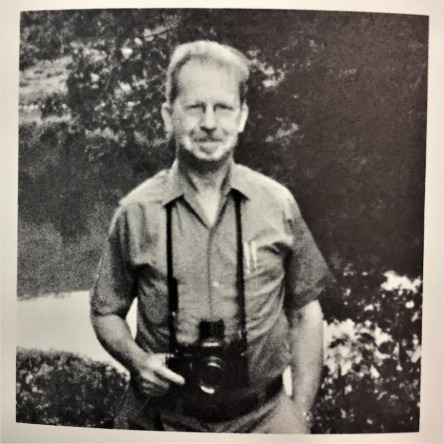
Figure 5: Graham Netting at Retirement in 1975.
As Netting prepared to step down as director in 1975, he said, “These great collections are a natural resource to answer questions about the life of the world.” On a recent day, I saw two children jumping up and down in front of the Glacier Bear diorama in Hall of North American Wildlife on a family visit to the museum. When one of the children asked, “what’s a diorama?” I thought about Graham Netting, smiled, and encouraged their engagement with the life of the world.
Many thanks to Xianghua Sun, Carnegie Museum Library Manager, Marie Corrado, Carnegie Museum Library Clerk, Stephen Rogers, Collections Manager for the Section of Birds, and John Wenzel, Director of Powdermill Nature Reserve for help researching this post.
Joann Wilson is an Interpreter in the Education Department at Carnegie Museum of Natural History and Albert Kollar is Collections Manager for the Section of Invertebrate Paleontology. Museum employees are encouraged to blog about their unique experiences and knowledge gained from working at the museum.
#Carnegie Museum of Natural History#Graham Netting#Wildlife diorama#Pittsburgh#Natural History#Powdermill Nature Reserve#Horn coral#Rugose coral#Louisville
41 notes
·
View notes
Text
I really should have evaluated the Eifel Volcanic Field shouldn’t I? I still can’t read the language but at least I know people who can. WHY did I have to get attached to a SPANISH volcano when I only read ENGLISH and FRENCH!!
1 note
·
View note
Text

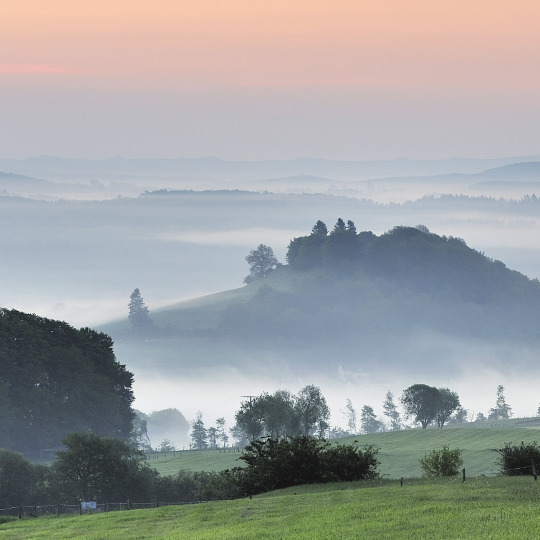
Details of the early morning in the volcanic Eifel
7K notes
·
View notes
Photo
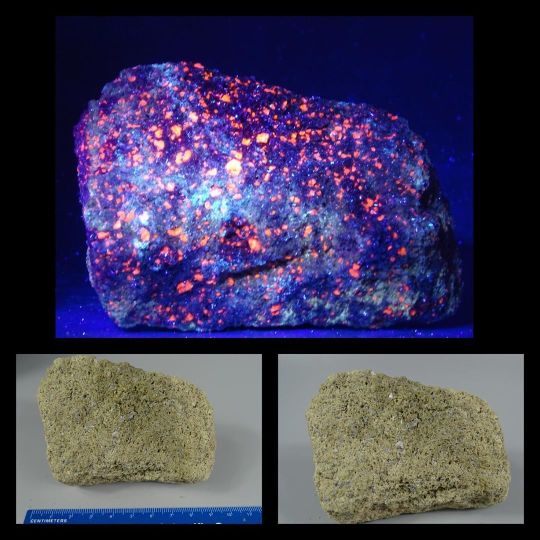
Fluorescent Nosean in Sanidine from Eifel Volcanic Fields, Germany. $10 plus shipping. 90 x 64 x 16 mm. 86 grams. . #nosean #sodalite #fluorescentnosean #fluorescentstones #sanidine #fluorescentnosean #mineralspecimens #minerals https://etsy.me/3dqoUme https://www.instagram.com/p/CBvwvETBgx4/?igshid=1rd36jna41mkh
6 notes
·
View notes
Text
You know, it truly is a mark of this year that I scrolled past a headline along the lines of VOLCANIC ACTIVITY IN THE EIFEL: ERUPTION IMMINENT?!?! and I didn’t immediately dismiss it as click-baity bullshit, as I usually would have, but rather thought, "This might as well happen”
#rather random#the media made me do it#life in the time of corona#2020 vision#adventures in geography
6 notes
·
View notes
Video
youtube
Maria Laach at the Laacher See in the volcanic Eifel - Abtei Maria Laach - Laacher See Vulkan Eifel
Maria Laach at the Laacher See in the volcanic Eifel. The abbey of Maria Laach is situated next to the volcanic caldera lake Laacher See in the East of the Eifel region halfway between the cities of Bonn and Koblenz.
Benediktinerabtei Maria Laach am Laacher See in der Vulkaneifel ►Fotos: https://simonfriedrich.blogspot.com/2019/05/abtei-maria-laach-laacher-see-vulkan.html #marialaach #germanytourism #laachersee
1 note
·
View note
Photo
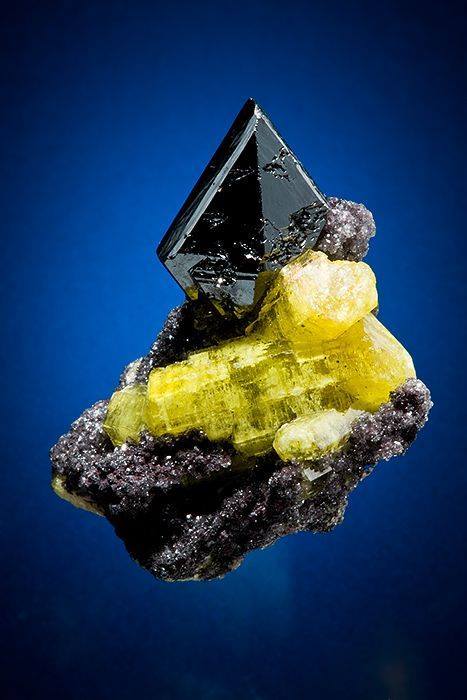
Manganite on Ettringite
Rare and fragile, these beautiful hexagonal crystals in the photo comes from the only source of this gemmy yellow sulphate mineral: The N'Chwaning Mines in South Africa's Kalahari manganese fields. Elsewhere it occurs as microcrystals, usually white to colourless. The mineral needs careful storage, since it is hydrated, and as water evaporates from the structure the colour turns white. It was first discovered in the Eifel Volcanic Field in Germany (see http://on.fb.me/1nJ2QtO), named in 1874 for the Ettringer volcano that spouted the lava flows which are its type locality. It forms when volcanic rocks intrude into limestones and freeze, baking the surrounding rock into a contact metamorphic aureole and spitting out element laced juices as they slowly freeze. This produces an exotic chemistry as the distillations of crust or mantle encounter limey rocks, forming a mineralogy known as skarns. Here the yellow Ettringite on matrix is accompanied by a lovely octahedron of Manganite, the most common oxide of this element.
Loz
Image credit : Keys Minerals
http://www.mindat.org/min-1414.html http://bit.ly/1JTX0j9
#manganite#ettringite#mineral#gem#sulfur#south africa#manganese#mineralmonda#the earth story#crystal
138 notes
·
View notes
Photo
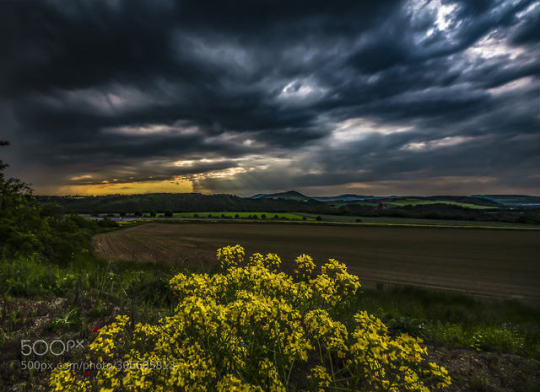
stormy evening at the volcanic Eifel by gerkenmartin Source: http://bit.ly/2K0bvWK
#mountain#valley#sky#evening#storm#color#colorful#cloud#clouds#rainy weather#dramatic sky#wide angle
1 note
·
View note

